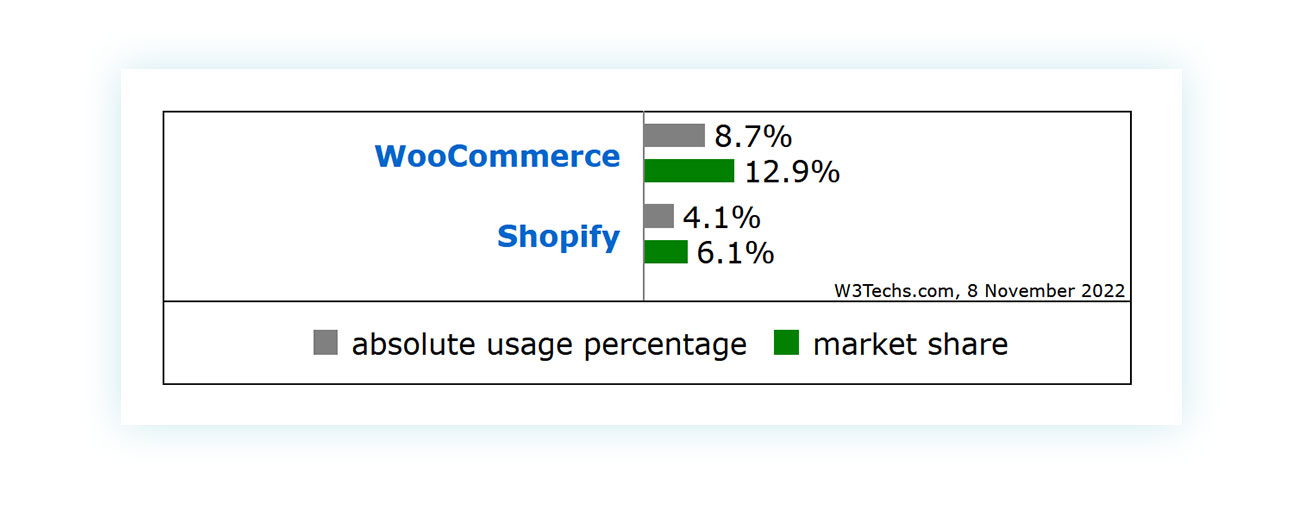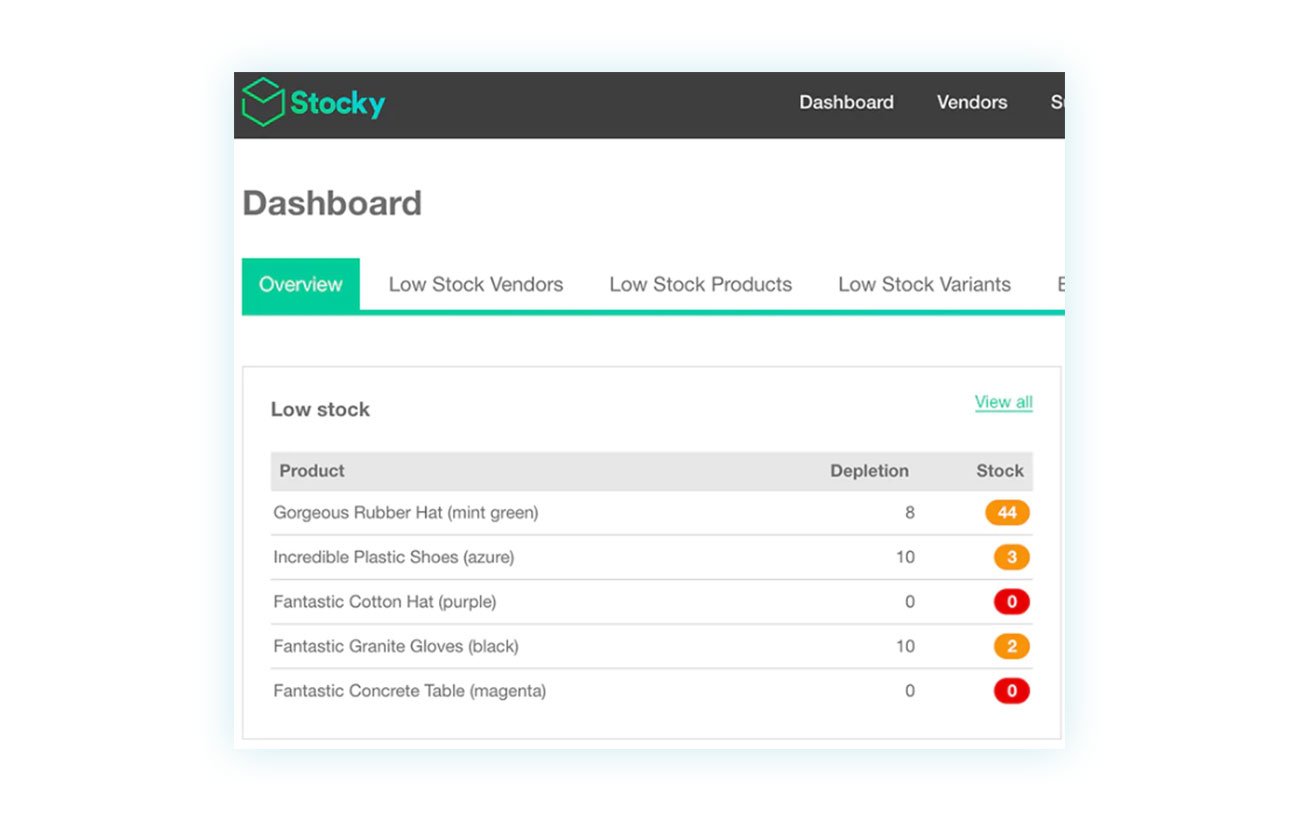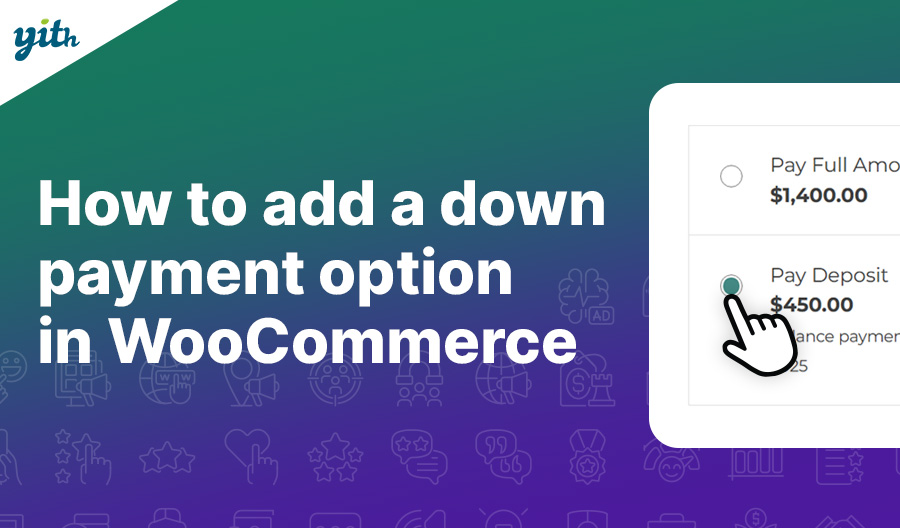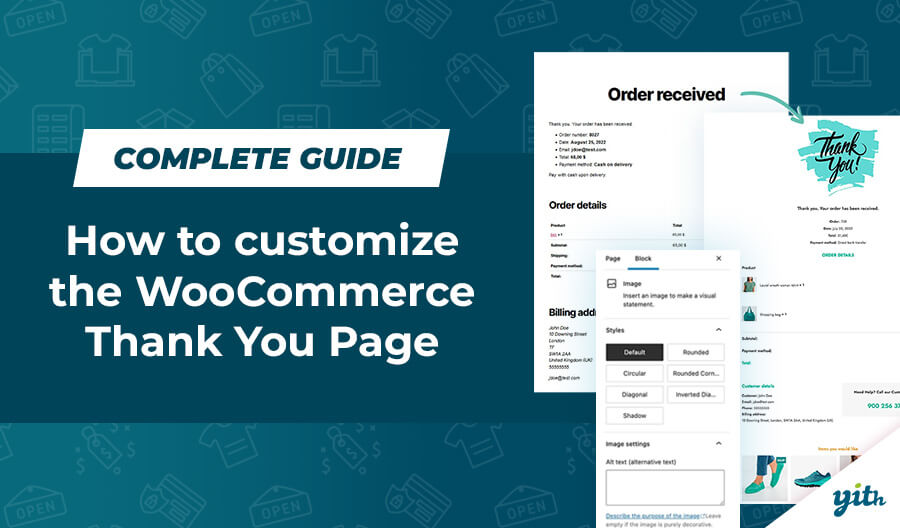Table of contents
- What is WooCommerce?
- What is Shopify?
- Shopify vs WooCommerce: what is the difference?
-
WooCommerce vs Shopify: Pros and Cons
- Which platform is the most cost-effective?
- The functionality of Shopify vs WooCommerce
- Design: WooCommerce vs Shopify
- The use of Shopify vs WooCommerce
- The support of Shopify vs WooCommerce
- WooCommerce vs Shopify: platform security
- The payment options of WooCommerce vs Shopify
- Ease of use: WooCommerce vs Shopify
- Inventory management in WooCommerce vs Shopify
- Which is best for SEO?
- Is it better WooCommerce or Shopify?
- Why prefer WooCommerce to Shopify?
You have finally decided to create your eCommerce store to sell products and/or services online or reshape your existing website.
After doing some online research to find a dedicated eCommerce platform, some names appear more frequently and you may be wondering: WooCommerce or Shopify? Which is the best solution for online sales and what changes between one service and the other?
These questions are legitimate; after all, we are talking about eCommerce platforms that have a huge reputation among users and it can be difficult to choose between the two.

On the one hand and according to W3Techs statistics, WooCommerce is used on 9.2% of sites worldwide and boasts a market share of 13.3% of online sales.
On the other hand, Shopify has smaller yet interesting numbers, with 4.4% of sites worldwide and a market share of 6.3%.
These solutions are still going strong and the numbers just keep on rising.

In fact, back in November 2022, WooCommerce was used only on 8.7% of the sites (0.5% less than today) with 12.9% of the market (0.4% less), while Shopify occupied only 4.1% (0.3% less) and had a market share of 6.1% (0.2% less).
These figures are not enough to compare the two services, but don’t worry: once you have read this article, you will have a clear idea of which is the best eCommerce platform for your products.
What is WooCommerce?
To get a handle on what WooCommerce is all about, let’s take a step back and introduce WordPress. We’re talking about an open-source CMS (Content Management System) and, as such, it’s completely free to use — you only need to pay for the hosting service.
WordPress is great for building all kinds of online sites, including blogs and eCommerce sites using WooCommerce as an open-source extension.

These tools represent the history of websites: WordPress, which was launched in 2003, is currently the most widely used CMS in the world, with over 800 million sites built on it (nearly half of the two billion sites online today).
WordPress has been so successful that a huge online community has been created on it, with virtual and physical events (the famous WordCamps), countless resources and guides, and much more. This success extends to WooCommerce with about 6 million active installations (although there are much higher numbers online).
We will go over all the advantages and disadvantages of this solution below.
What is Shopify?
Unlike WooCommerce, which bases its identity on being an open source service, Shopify is a Canadian company founded in 2006. In its eighteen years of service, Shopify has managed to host more than four million stores worldwide, with sales of more than $300 billion.

What characterizes these popular eCommerce platforms is the simplicity of use, but Shopify makes it even easier to set up an online store without great demands for customization.
The user, will not be required to find a hosting provider and purchase a domain, as these steps are contained within the installation phase. An eCommerce store (in its basic form) can be built in a matter of minutes, although a service fee will be charged.
To understand the advantages and disadvantages of this choice, however, it is necessary to go into detail about the WooCommerce vs Shopify challenge.
Shopify vs WooCommerce: what is the difference?
Considering what was suggested earlier, the very nature of the eCommerce platform is linked to the many differences between the two services.
As an open-source solution, WooCommerce relies on a huge community that provides stable growth and free access (there is no need to pay to use it).
This freedom of access has guaranteed the development of thousands of plugins and themes, as well as a customization advantage that can be easily applied to every aspect of the platform. In this way, it is possible to create a site exactly as imagined, ranging from a simple eCommerce website to marketplaces, as well as booking and rental services.

Of course, in this case, the person in charge of the configurations of the website will require a basic knowledge of WordPress.
On the other hand, Shopify, born as SaaS (Software as a Service), is based on creating a fast and easy service for all kinds of sellers. The possibility of customization is limited compared to WooCommerce, but not impossible.
One of its strengths (but also weaknesses, as we will see shortly), it’s the initial set-up simplicity: while WooCommerce requires the seller to purchase a hosting plan and a domain, Shopify allows everything to be done directly on the company’s site.
This, however, results in two limitations: the first one, less efficiency for other aspects of the site (many sellers use the Shopify store as a sub-domain to integrate it into a portal where there is a blog) and, secondly, a potentially higher cost of management.
Finally, Shopify allows local sales management in your physical shop thanks to the Shopify POS system (at an additional cost of €77/month per location).
As you can see in the next point, while there are many differences between the two services, it is not easy to decide which is the best solution to the WooCommerce vs Shopify question, as it depends entirely on the seller’s needs.
WooCommerce vs Shopify: Pros and Cons
The best way to find the ideal eCommerce platform is to evaluate your online store needs and, based on it, see how each solution will respond to them. For more clarity, let’s think of a watch: for a person who dives, the best watch is the one that has a high resistance to water pressure, but, we can’t rely on the same parameter to choose the best watch for another person.
So let’s see, point by point, where the needle of the scales points in the WooCommerce vs Shopify comparison.
Which platform is the most cost-effective?
Let’s start talking about a fundamentally important aspect: the financial investment you will have to make to set up your online store. After all, at the end of the day, your profit comes from the income and expenditure of your site, which is why it is important to have a clear picture in mind.
Usually, when it comes to associated costs, WooCommerce is the cheapest solution. Not only because both WordPress and WooCommerce are free, but also because you have the option of choosing the most suitable hosting plan for your budget.
Another additional cost associated with this platform is the supplementary plugins to add special features to your site, which are often linked to an annual fee.
On the contrary, Shopify allows you to create an eCommerce store directly on its site, with three types of monthly subscriptions that can be chosen according to your needs.

The “Basic” Shopify solution, the cheapest one, requires an investment of 21€/month and is suggested for new online businesses with a limited number of sales. The intermediate solution, called “Shopify”, requires an investment of 59€/month, up to the “Advanced” solution with a cost of 289€/month (there is also Shopify Plus, designed for large companies, with a cost starting at 2000€/month).
It’s also worth remembering that sales commissions can have a big impact on final profits. For example, for stores based in Europe, Shopify charges a maximum of 1.9% on payments made with a European credit card and 3.6% on all international cards.
This percentage drops depending on the Shopify plan: for the “Advanced” to 1.6% and 3.2% respectively.

Note: To each of the above percentages, a fixed fee of 0.25€ per commission must be added, which has a considerable impact in the case of selling low-cost products.
Although both platforms come with paid plugins/apps, the average cost of Shopify’s apps is higher than the ones offered by WooCommerce.
In summary, a WooCommerce store is a significantly cheaper solution than a Shopify store, even if the creation of the site requires more dedication.
The functionality of Shopify vs WooCommerce
One of the core differences between these two platforms is the number of functionalities integrated within them. As specified above, Shopify offers the seller a ready-made shop with certain functionalities considered essential for better sales conversion.
These include the ability to retrieve customers’ abandoned shopping carts, save the items contained in them and send an email to remind users of their unfinished purchases.
This function is certainly not included by default in WooCommerce, but it is possible to add it using a dedicated plugin, such as WooCommerce Recover Abandoned Cart (many other plugins allow you to add very important functions, such as a Live Chat or to have more control over your conversion).
An advantage of Shopify sites, however, is the automatic scalability of the service: being an integrated service of Shopify itself, shops built on this platform tend to be faster than the average shop built on WooCommerce.
Of course, we are not talking about seconds of difference, but milliseconds: an analysis by Quanta showed that, on average, a Shopify store loads in half the time compared to a WooCommerce site.

This is linked to both Shopify scalability and, above all, to the web hosting services chosen by WooCommerce users. Unfortunately, to avoid high costs, many new store owners opt for the cheapest web hosting plan on the market, which may result in longer loading times and greater downtime risks.
Consequently, this means that by opting for a good hosting service, it is possible to reach even on WooCommerce sites at the speed offered by Shopify.
Design: WooCommerce vs Shopify
The design is the visual appearance of your site, which is influenced (on both platforms) by the theme chosen by the seller.
The appearance of your site is not only a manifestation of your style, but it also adds to the level of conversions you get from your customers. In fact, in 2018, BlueCorona pointed out that 38% of users stop their navigation and abandon the site if it does not satisfy them aesthetically.
Again, it is difficult to identify which is the winner in the Shopify vs WooCommerce comparison, in both cases, it depends on how much time you want to spend setting up your online store.
Shopify offers a variety of free and paid theme options, which can be further customized via code, but the same is also true for WooCommerce.

In both cases we are talking about thousands of themes available on the web, so where is the difference?
The Shopify themes offered within the platform’s store are usually better performing at the time of purchase, following the service’s mission that guarantees ease and speed of use.
On the other hand, WooCommerce themes allow greater customization, and it is not uncommon for premium themes to require custom work to adjust and increase their potential.
Again, the choice depends entirely on the type of site you want to create.
The use of Shopify vs WooCommerce
We have already mentioned this aspect before, but now it is time to expand our analysis further. Very often, the decision (Shopify vs WooCommerce) is simply linked to the type of use a seller wants to make of it.
If you need to offer your products online and create an online store in just a few clicks, a basic Shopify plan may be the answer for you.
On the other hand, WooCommerce allows you to customize every aspect of your shop, thus allowing you to transform it to better suit your business.

Want to offer a subscription to your customers? You can use the WooCommerce Membership extension to offer exclusive content to your subscribers. Want to create a marketplace like Etsy or eBay for your local business? The WooCommerce Multivendor plugin allows you to have as many sellers as you want on your eCommerce store. WooCommerce offers an advanced and complete solution for any type of site you wish to create.
It is also important to think about your long-term goals. Shopify often takes a larger commission than WooCommerce, but WooCommerce requires more time and effort upfront and offers more benefits in the long run.
The purpose of the site is also something to consider: if the online store is only a part of your portal, you might want to choose WooCommerce. WordPress, the platform on which this plugin runs, allows you to create all kinds of sites, with a blog to improve the indexation of your portal.
The support of Shopify vs WooCommerce
If in terms of price WooCommerce is the clear winner, yet, when it comes to customer support the first prize goes towards Shopify.
After all, Shopify offers a private service that has control over the creation of your site and hosts it within its servers.
It is undeniable that this option is of paramount importance for those who create their online store, as any problems or misunderstandings on the site can cause financial losses and damage the store’s reputation.

What about WooCommerce stores? Is there a way to get help on the platform? In this case, support is offered in several channels.
Since it is free, WooCommerce enables contact with a huge community that shares the same altruistic spirit, any problem can be solved through a post in the dedicated support forum.
On both platforms, problems requiring direct technical support intervention are rare, but, in this case, Shopify offers a faster problem resolution than the WooCommerce community.
On the other hand, if the problem is related to a previously purchased plugin, you can count on the direct assistance of the developers to solve it in no time. YITH, for instance, despite its millions of customers, treasures a 97% satisfaction rate thanks to the continuous efforts of its support team.
WooCommerce vs Shopify: platform security
The topic of security is one of the most important online: ensuring the best coverage is vital when browsing the website and when paying with credit cards.
Low-level security can lead to risks for both seller and buyer, but which eCommerce platform is the best in this respect?
Let’s start by saying that usually, the biggest risk to a site’s security is a human mistake, so paying attention to inadvisable activities and tools can dramatically reduce it.
On the one hand, Shopify certainly makes security management easier, as it is an internal platform service that provides the SSL certificate and the PCI-DSS standard.
Both of these can (and should) also be applied to WooCommerce, although it requires direct intervention by the site operator.
Furthermore, there is a misconception that WordPress, as a platform, is not safe and more susceptible to online attacks. This is not necessarily the case: according to PatchStark, only 0.58% of the security flaws are caused directly by WordPress.
In the vast majority of cases, these breaches are caused by unreliable plugins or themes that damage the security of the platform itself, reducing the store owners’ control.

Basically, Shopify isn’t necessarily safer than WooCommerce. It all depends on what sellers do to make sure the site works properly for them. One good thing about Shopify is that apps must meet certain quality standards to be accepted and added to the store. Unlike WordPress/WooCommerce plugins, anyone can create one of those and put it online. This is why it’s still important to do thorough research before using a plugin developed by a third party on WooCommerce.
The payment options of WooCommerce vs Shopify
Speaking of payment options, the core difference between the two platforms remains related to the commission percentage charged by Shopify.
In most cases, especially if you manage a large number of products or sell low-cost digital products, your business will be deeply affected by the commission charged on the prices of your shop.
When it comes to a direct comparison of the available payment methods, both Shopify and WooCommerce offer the most commonly used solutions online, including PayPal and payment with credit and debit cards.

The difference lies in the methods integrated within the store: while WooCommerce requires the use of dedicated payment plugins, such as WooCommerce Stripe for credit cards, Shopify also offers a basic system that allows most of the most frequently used methods, for a fee.
In this case, WooCommerce rises as the best choice, particularly if you expect large order traffic on your online store.
Ease of use: WooCommerce vs Shopify
Even though the comparison constantly shifts between one platform and the other, in this regard, we have to award the prize to Shopify.
After all, we are talking about a service that makes configuration simplicity its strong point. On the contrary, WooCommerce requires a greater investment of time and energy.

Of course, this does not mean that WooCommerce is difficult to use, on the contrary: both WordPress and WooCommerce require only a minimum knowledge of the website and their operation has become, update after update, increasingly intuitive.
Basically, on one side, we are talking about a service offered to a customer, and, on the other, about a personal project that requires more involvement, but with greater potential.
Inventory management in WooCommerce vs Shopify
Inventory management is a fundamentally important element for any shop, be it physical or online. You cannot risk selling a product or service that is no longer available, this would result in refunds and damage to the brand image.
Fortunately, inventory management is simple and intuitive on both platforms, with the possibility to control the number of products at any time.
Moreover, on both WooCommerce and Spotify it is possible to further improve this management through the use of dedicated apps. On the former, it is possible to use Stocky, which makes inventory more intuitive and easy to control.

Similarly, YITH offers its Point of Sale for WooCommerce plugin, which allows you to synchronize your catalog between the various points of sale so that you are in control of your stock at all times.

Which is best for SEO?
Another aspect of fundamental importance for indexing your portal in web searches is SEO. This very famous acronym stands for Search Engine Optimisation (SEO) and allows you to position your portal among the first results during a Google search.
Although both platforms, WooCommerce and Shopify, enjoy some SEO management tools, in this section, WooCommerce results as the winner of the comparison as it is equipped with more plugins and pointers that can make a difference, especially for online stores that want to compete with the biggest companies on the market.
Is it better WooCommerce or Shopify?
This is a question that everyone looking to open an eCommerce store asks themselves, and to find the answer it is important to think about your specific needs as a seller.
As it is easy to understand from this comparison article, simply WooCommerce and Shopify meet different market needs, so it is essential for shop owners to understand which side they are in and what they are looking for from their online store.
Why prefer WooCommerce to Shopify?
Although the choice depends on the needs of the seller, it is undeniable that WooCommerce occupies a larger share of the market. But, what is the reason for this?
Many store owners choose WooCommerce over Shopify for its freedom of customization. An eCommerce store built on this platform has the potential to become any kind of commercial reality, whereas Shopify tends to have its limitations.
Furthermore, many sellers have a precise idea of their shop, and the freedom offered by WooCommerce makes it easier to achieve certain specific goals.
Finally, it is undeniable that a factor behind this choice is the cost of the service: not only in the form of the monthly subscription but especially in the percentage loss due to commissions on sales. If you don’t have a large profit margin on your sales, the commissions charged by Shopify could potentially hurt your business.
This is, therefore, why so many store owners choose WooCommerce, even though they know that this choice will require a greater investment of time (especially in the first phase of creating the store).



